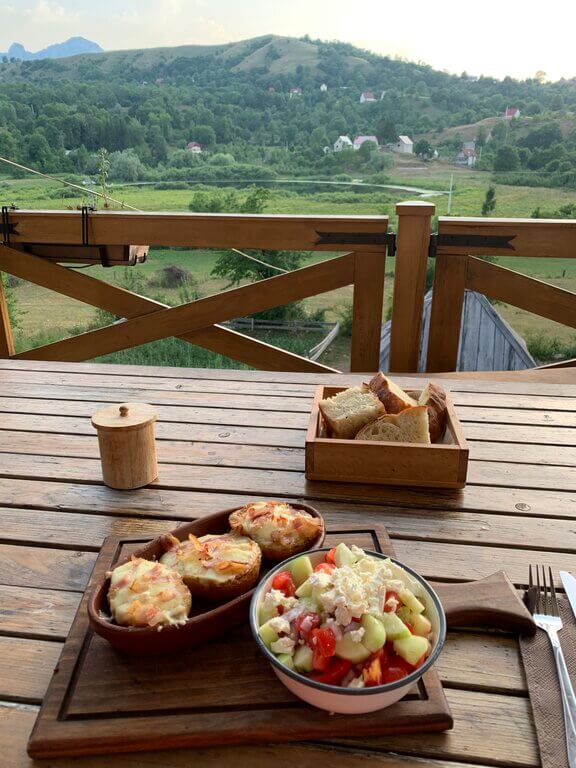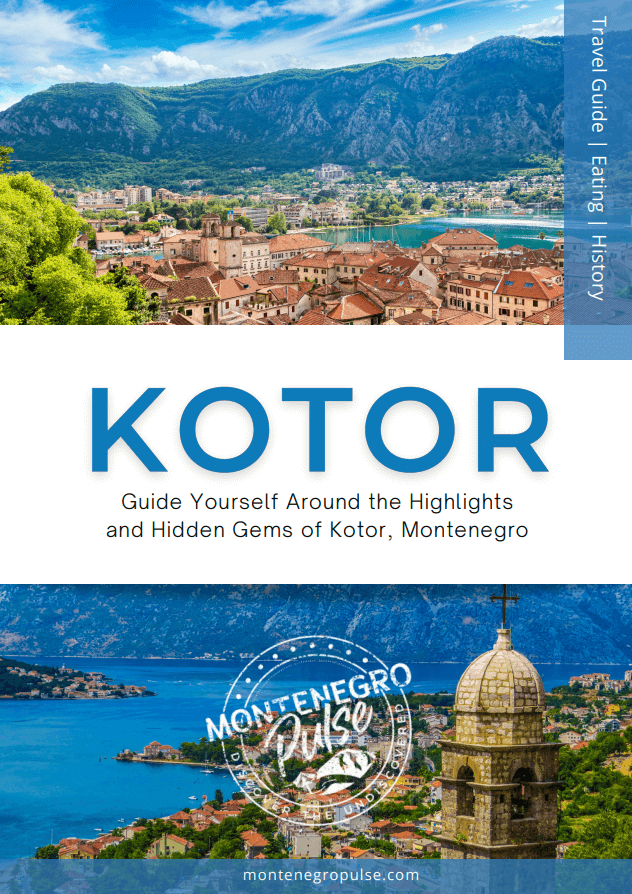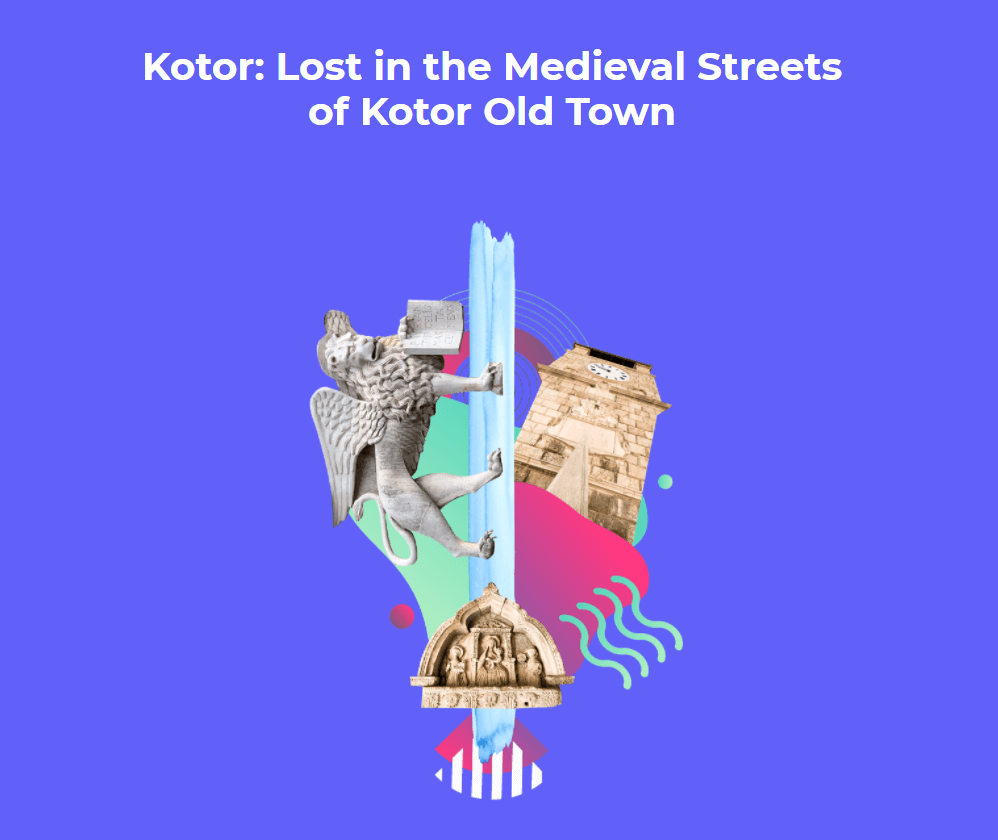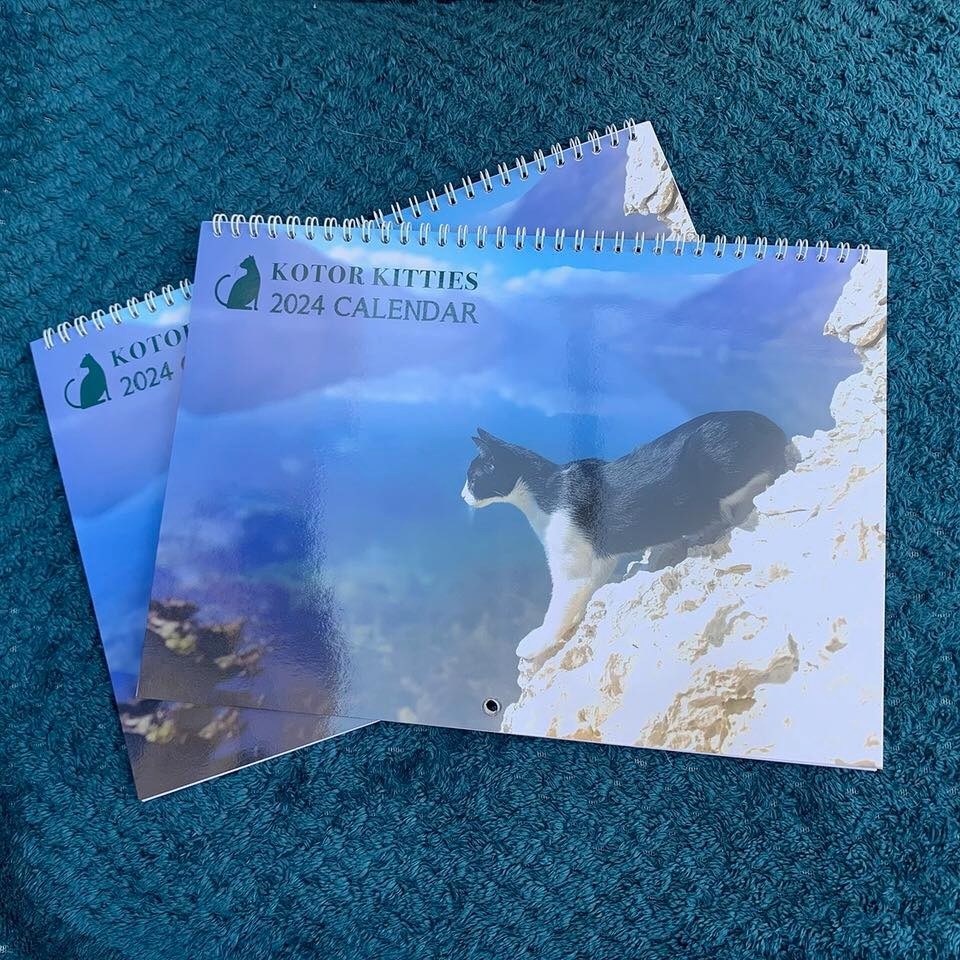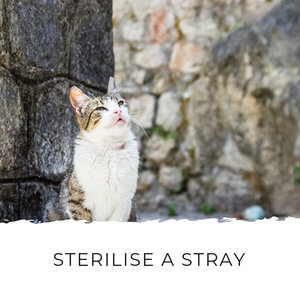Montenegro Pulse contains affiliate links and is a member of the Amazon Services LLC Associates Program. If you make a purchase using one of these links, I may receive compensation at no extra cost to you. See my disclaimer for more information.
Mountains of Montenegro: Best Destinations and Things to Do
Explore the mountains of Montenegro! Discover the main mountain ranges, highest peaks, and local stays in the Dinaric Alps, Durmitor, and more.
Did you know that this beautiful country is characterized by its mountains?
A full two-thirds of Montenegro’s 13,812 square kilometer area is considered mountainous, and Montenegro’s mountains are known as some of the most rugged mountain terrains in Europe.
In fact, Montenegro is named for its dramatic mountain scenery. Montenegro translates as Black Mountain. Monte = mountain and negro = black.
Montenegro has a whopping 4,573 peaks, 50 of which are over 2,000m, and the scenery and opportunity for outdoor activities here are stunning!
You also don’t need to spend a lot of time traveling to see Montenegro mountains, you can easily experience some of the important mountains of Montenegro in as little as an hour from the coast.
On this page you’ll find out about the main mountains of Montenegro and the best destinations for experiencing them. You’ll also find out the best things to see and do, what to eat, and where to stay.
Contents
What to Eat in the Mountains of Montenegro
Geology of the Mountains of Montenegro
Ecology of the Mountains of Montenegro
FAQ About the Mountains of Montenegro
Major Mountains of Montenegro
Dinaric Alps
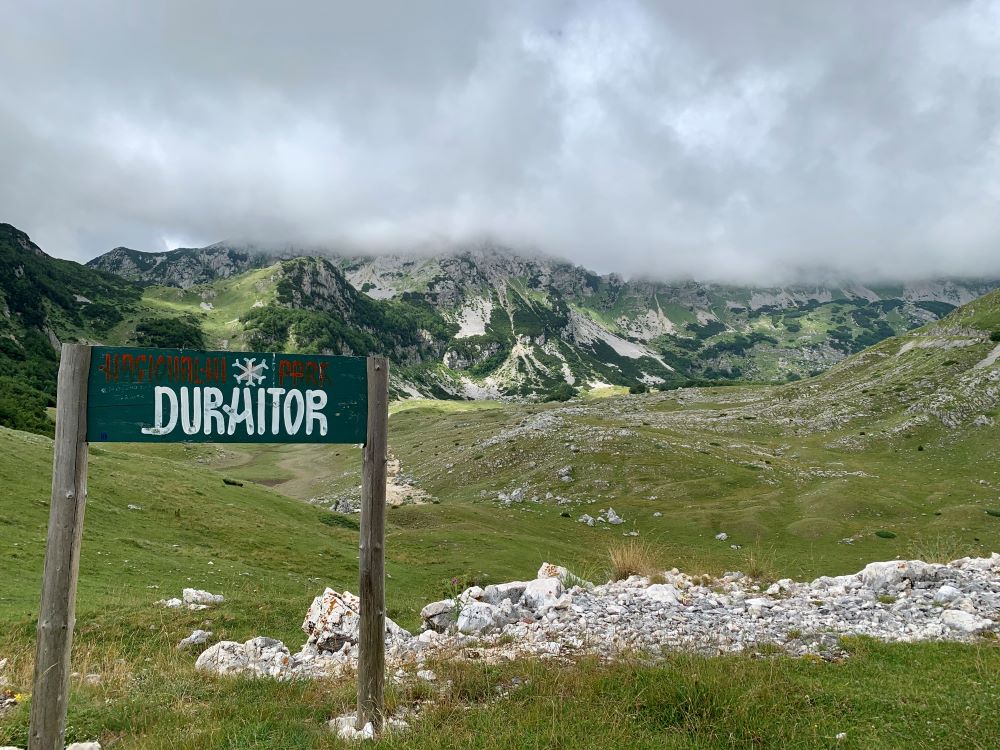 Durmitor National Park, part of the Dinaric Alps
Durmitor National Park, part of the Dinaric AlpsNestled in the rugged heart of the Western Balkans, the Dinaric Alps (also known as the Dinarides) stretch 645 km (401 mi) from Italy, through Slovenia, Croatia, Bosnia and Herzegovina, Serbia, Montenegro, and Kosovo to Albania.
In Montenegro, the Dinaric Alps extend along the western part of the country and encompass the Prokletije, Lovćen, Durmitor, Orjen, Rumija, Sinjajevina, Hajla, Maganik, Njegoš, and Bijela Gora mountains.
This mountain range in Montenegro, characterized by its limestone karst formations, densely forested slopes, and deep river canyons, creates a natural border between the coastal regions and the continental hinterland.
Best Things to See and Do in the Dinaric Alps
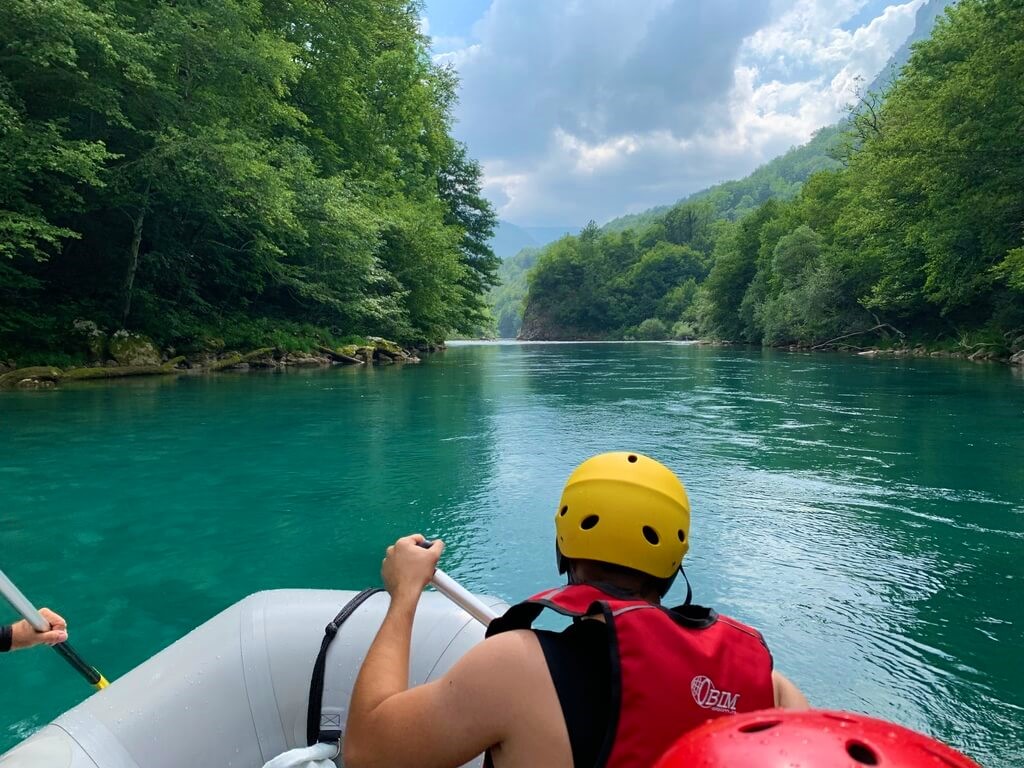 Rafting in the Tara Canyon
Rafting in the Tara Canyon- Rafting: The Tara River Canyon, part of the Dinaric Alps, is a must-visit in the mountains of Montenegro. It's the second-deepest river canyon in the world and offers fantastic white-water rafting experiences.
- Canyoning: Canyoning is one of the most popular adventure activities you can do in Montenegro. Nevidio Canyon, near Durmitor National Park, offers one of the most challenging and fun canyoning experiences in Montenegro.
- Hiking: There are dozens of hiking trails in all the locations that form part of the Dinaric Alps in Montenegro. If you’re interested in hiking in Montenegro, I highly recommend The Mountains of Montenegro, A Walker’s and Trekker’s Guide by Rudolph Abraham.
- National Parks: Three of Montenegro’s five national parks are in the Dinaric Alps - Lovćen, Durmitor, and Prokletije. These are fantastic places to experience the Montenegro mountains.
Highest Peaks of The Dinaric Alps
- Zla Kolata: Zla Kolata is the highest peak in Montenegro at 2,534 meters, located in the rugged Prokletije mountain range. This challenging summit attracts experienced hikers and mountaineers wanting to conquer its steep and scenic trails.
- Bobotov Kuk: At 2,522 meters, Bobotov Kuk is not only the highest point in the Durmitor range but also offers some of the most breathtaking views of the Dinaric Alps.
Most Popular Hiking Trails in the Dinaric Alps
- Bobotov Kuk: A challenging but rewarding hike, this trail takes you around the peaks of Durmitor National Park, including a climb to Bobotov Kuk. It’s perfect for experienced hikers seeking spectacular views.
You can hike this trail on your own or book a guided tour from Kotor or from other locations around Montenegro. - Via Dinarica: Europe’s newest mega trail that covers 2,000 km across several countries in the Balkans, including Montenegro, the Via Dinarica offers a unique way to experience the cultural and natural heritage of the Dinaric Alps.
You can hike sections, the whole trail, and book guided hiking tours on this trail.
Best Places to Stay Near the Dinaric Alps
- Žabljak: Located in the heart of Durmitor National Park, Žabljak is Montenegro's most popular mountain town. Here, you'll find a range of accommodations from rustic lodges to comfortable hotels. Click here to find accommodation in Žabljak.
- Plužine: Situated on the shores of pretty Piva Lake, Plužine is a peaceful retreat after a day of hiking or rafting, with options for both budget and upscale stays. Click here to find accommodation in Plužine.
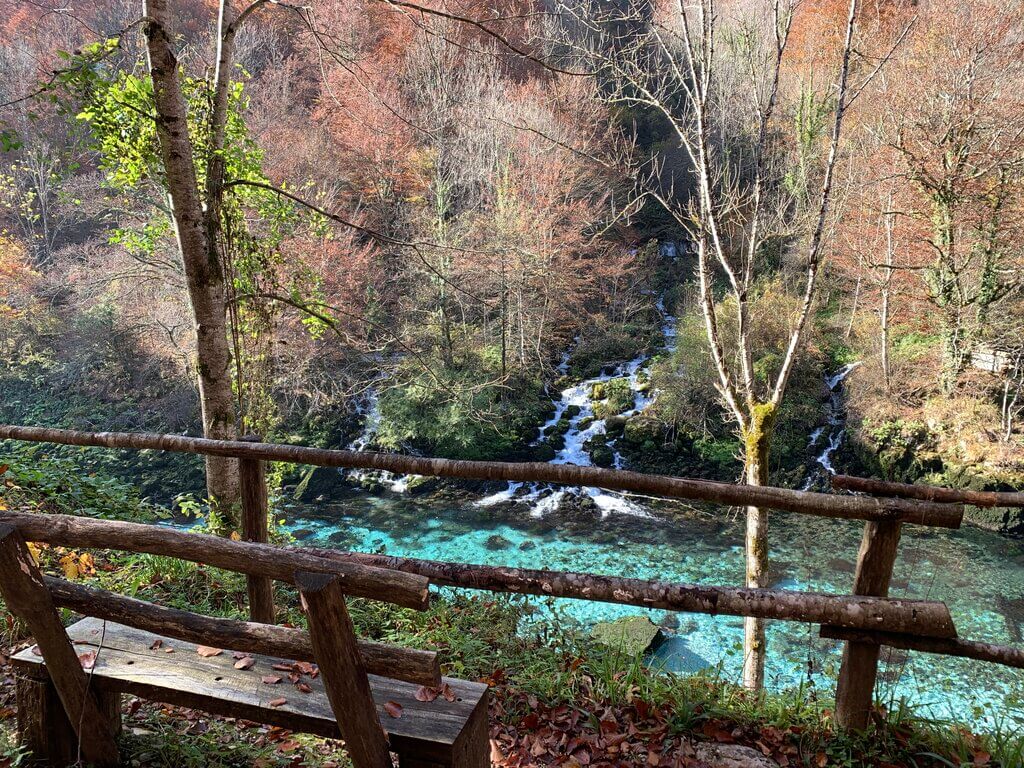 Stunningly beautiful Piva River near Piva Lake
Stunningly beautiful Piva River near Piva LakeDurmitor
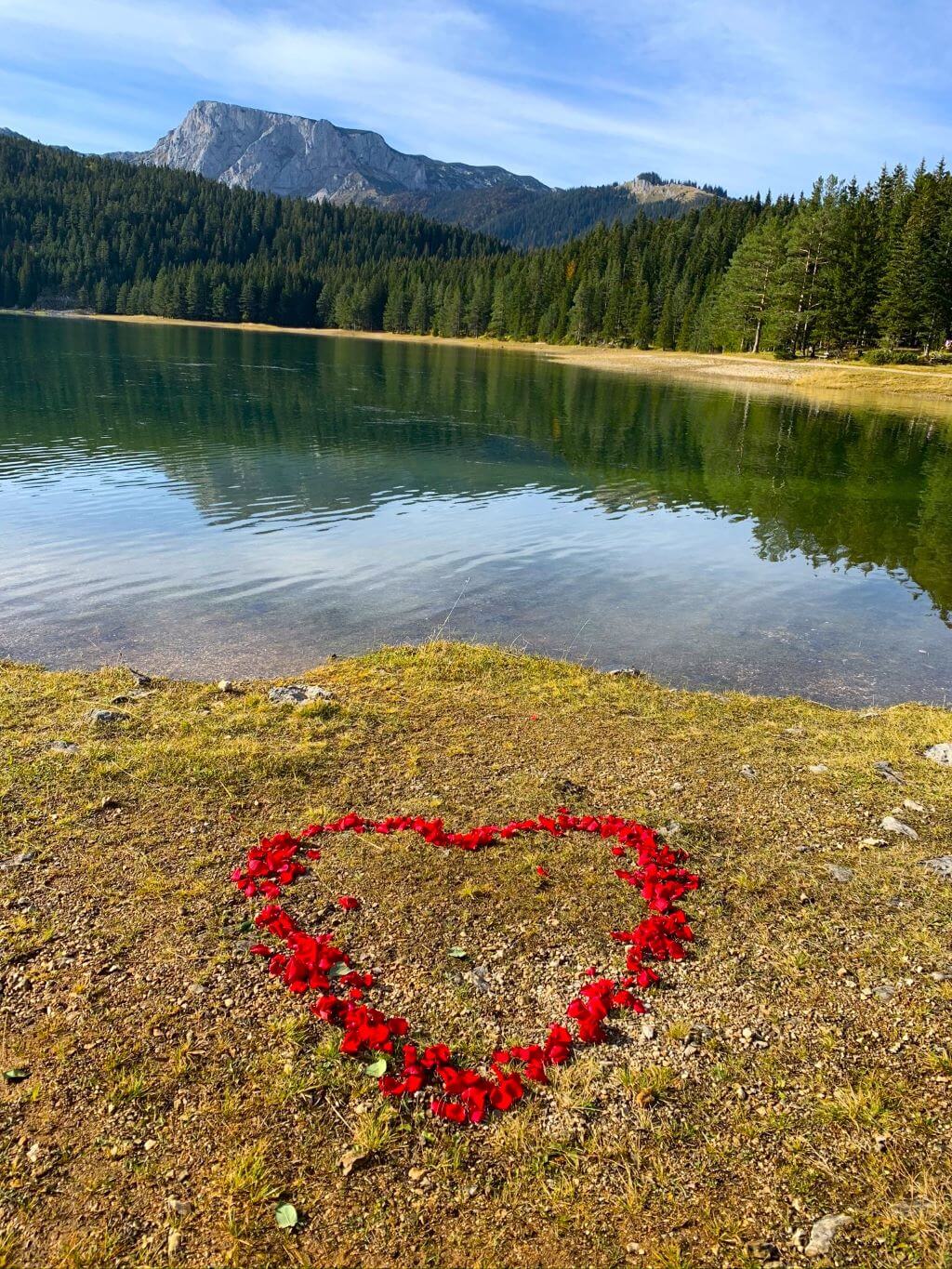 The Black Lake in Durmitor National Park
The Black Lake in Durmitor National ParkDurmitor is a large mountain range that forms part of Durmitor National Park, a UNESCO World Heritage site.
Located in the northwest part of the country, Durmitor is renowned for its stunning glacial lakes, known as "mountain eyes," rugged mountain peaks, and verdant pine forests.
This park offers some of Montenegro’s most dramatic mountain scenery and is a hub for all kinds of outdoor activities.
Best Things to See and Do in Durmitor
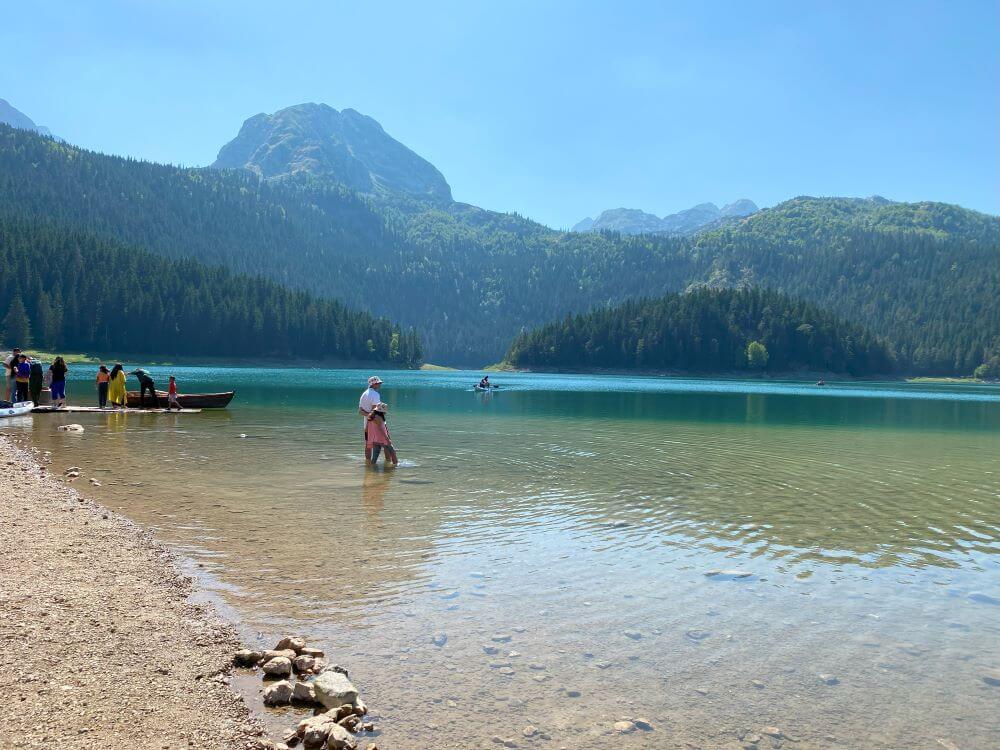 The Black Lake
The Black Lake- The Black Lake: The 4km track around the Black Lake is an easy and popular way to experience Durmitor. You can also hire a boat or kayaks on the lake.
- Durmitor Ring: Durmitor Ring (Durmitorski Prsten) is a circuit route of around 76km that will take you through some of Durmitor's most stunning scenery. The Sedlo Pass is particularly beautiful and has some great photo ops.
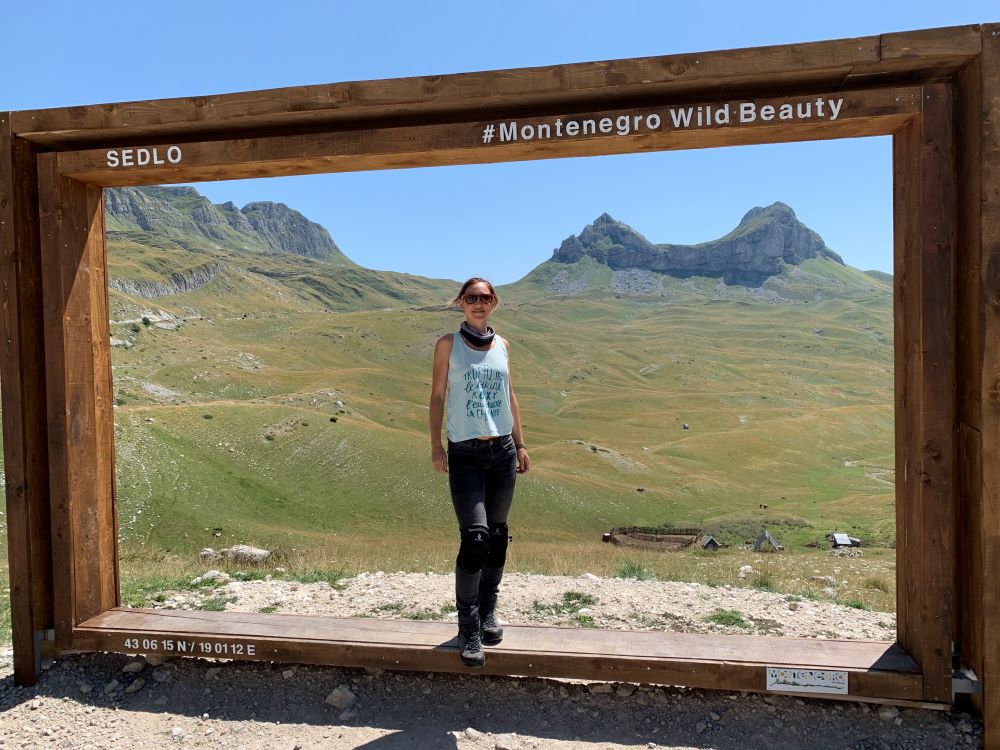 Sedlo Pass on the Durmitor Ring
Sedlo Pass on the Durmitor RingMontenegro Car Hire Deals
You'll need a car to get to many attractions like the Durmitor Ring in the mountains of Montenegro, so I recommend hiring a car for your trip.
The best place to rent a car in this region is Localrent. They work with local rental agencies to bring you a huge choice of cars with great contracts (like low deposits) at 5-25% lower prices than you'll find elsewhere.
- Tara River Canyon: The Tara Canyon is the deepest canyon in Europe and the second-deepest canyon in the world after the Grand Canyon.
- Đurđevića Tara Bridge: once the highest vehicular concrete arch bridge in the world, this is the best place to see the Tara Canyon. You can also zipline across the canyon from the bridge.
- Rafting in the Tara Canyon: one of our must do activities every summer, white water rafting in the Tara Canyon is lots of fun and the scenery is simply stunning.
- Via ferrata: a mix between rock-climbing and hiking, the Durmitor via ferrata is an awesome way to experience Durmitor’s dramatic peaks.
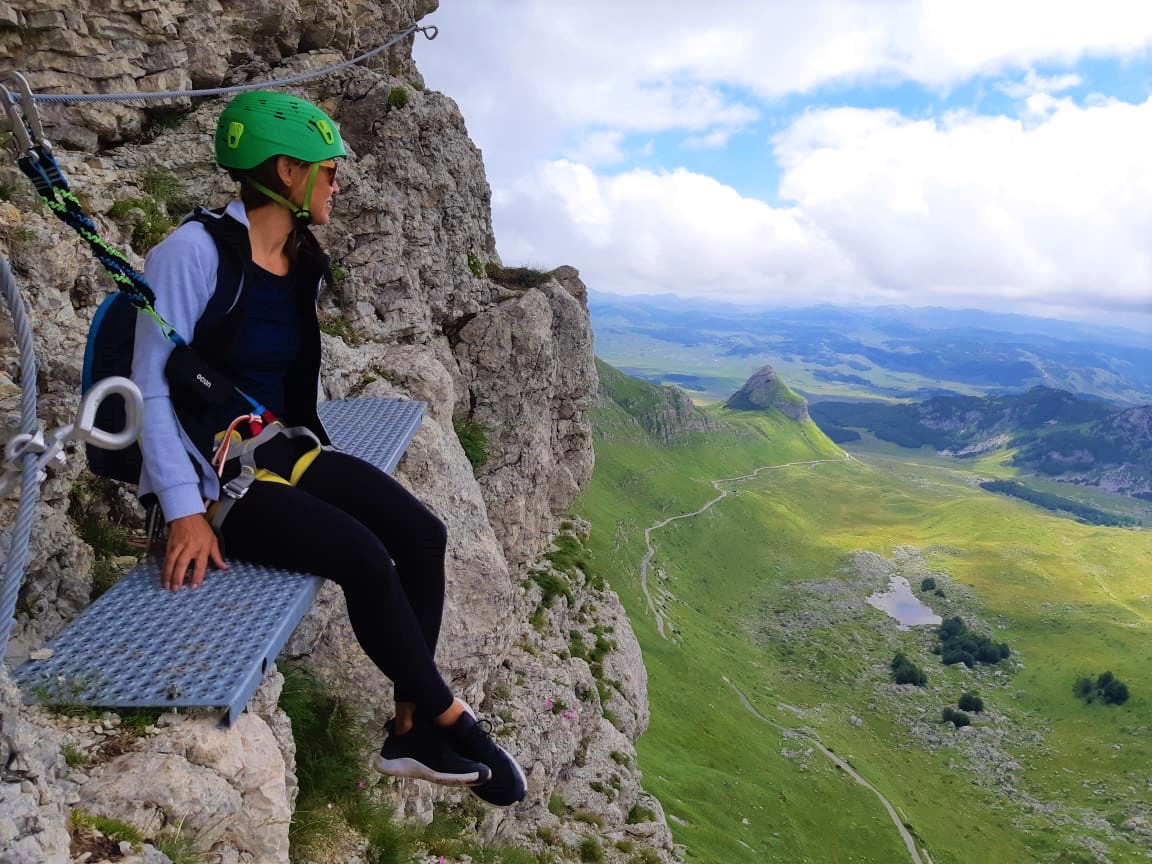 Via Ferrata, Durmitor National Park
Via Ferrata, Durmitor National Park- Nevidio Canyoning: test yourself on Montenegro’s most popular canyoning tour. Hike, swim, rappel (abseil) and jump your way through Nevidio Canyon. This is the ultimate fun for thrill-seekers.
- Bogumiljski Stećci: Bogumiljski Stećci are medieval Greek tombstones from the 7th to 8th century that lie near Riblje Jezero.
- Bobotov Kuk: A popular hike to the peak of Bobotov Kuk at 2,523m. Taking a guide is recommended because of changeable weather and general safety.
- Ski and snow: Durmitor’s Savin Kuk ski resort is a modest resort with a black run, red run, three blue runs and a baby run.
- The Durmitor, Tara and Ostrog Monastery Day Trip: This highly-rated small group tour includes the Black Lake and the Đurđevića Tara Bridge, breakfast in Nikšić, and a visit to Montenegro’s most revered religious site, Ostrog Monastery.
Highest Peaks in Durmitor
- Bobotov Kuk: 2,522 meters
- Savin Kuk: 2,313 meters
- Medjed Peak: 2,287 meters
Most Popular Hiking Trails in Durmitor
- Black Lake: This easy 4 km trail around the Black Lake is the most accessible and popular trail in Durmitor.
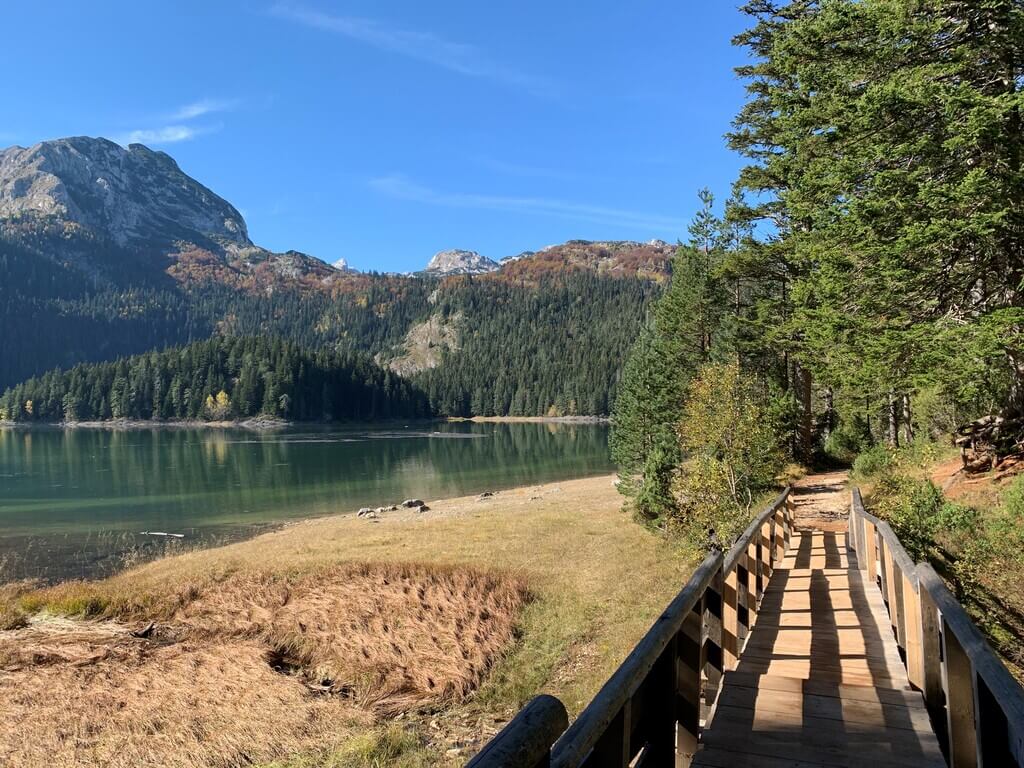 Trail around the Black Lake
Trail around the Black Lake- Bobotov Kuk Trail: This trail leads to the top of Durmitor’s highest peak, offering panoramic views over Montenegro and beyond. It’s a challenging hike, recommended for those with good fitness levels.
You can do this hike on your own or book a guided tour. - Other popular hikes here include Ice Cave (Ledena Pećina), Red Rock (Crvena Greda), Planinica, Mount Prutaš, Šrčko Lake, and Zeleni Vir.
>> Find more popular hiking routes on the Durmitor National Park page.
Best Places to Stay Near Durmitor
- Žabljak: The best place to stay in Durmitor National Park is in the little mountain town of Žabljak. Žabljak offers a variety of accommodations ranging from cozy mountain chalets to modern hotels and I recommend spending at least one night here. Click here to browse accommodation in Žabljak.
- Ethno Villages: For a traditional experience, try an ethno village (etno selo). Ethno villages typically offer private bungalow accommodation in a rural environment and traditional cuisine.
Etno Village Sljeme offers charming wooden cabins with stunning mountain views and local cuisine, just a short drive from the main attractions in Durmitor.
Bjelasica
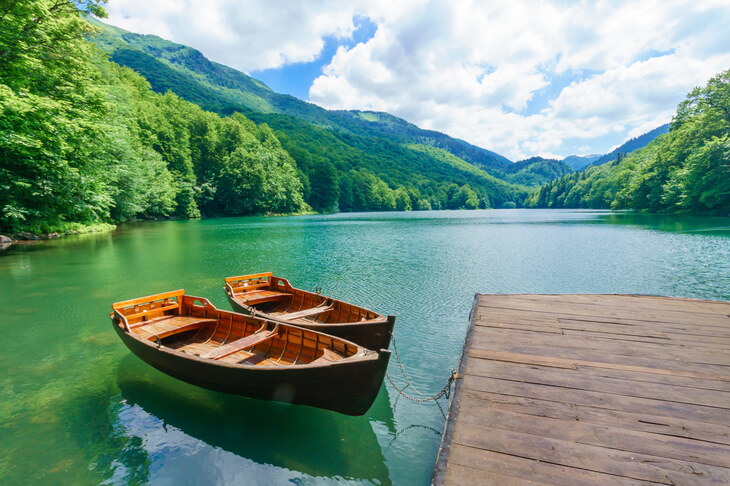 Lake Biograd in Biogradska Gora National Park. Image: Deposit Photos
Lake Biograd in Biogradska Gora National Park. Image: Deposit PhotosBjelasica is an idyllic mountain range in northern Montenegro, renowned for its gentle, rolling peaks and lush, verdant meadows.
This mountain range stands out for its accessibility and the rich biodiversity that thrives within Biogradska Gora National Park, one of the last three large virgin forests in Europe.
Bjelasica's scenic beauty makes it perfect for hiking and the traditional katuns (shepherd’s huts) found here offer authentic mountain culture and cuisine.
Best Things to See and Do in Bjelasica
- Lake Biograd: Wander through Biogradska Gora's ancient forest, where you can follow the educational trail around the lake or hire a boat to row around it.
- Horseback Riding: Explore the open landscapes of Bjelasica on horseback, a relaxing way to enjoy the mountain's natural beauty and panoramic views.
- Snow Sports: In winter, the Kolašin 1450 and Kolašin 1600 ski areas on Bjelasica offer excellent skiing and snowboarding, while summer activities include, hiking, mountain biking, and jeep safaris.
- Hiking: You'll find several trails of varying difficulty and authentic experiences staying in traditional katuns. You can find out more about the trails and accommodation on this page.
- Jeep Safari: Take a scenic jeep safari through Biogradska National Park to see the rolling hills and katuns of Bjelasica.
Highest Peaks in Bjelasica
- Crna Glava: 2,139 meters
- Zekova Glava: 2,117 meters
Most Popular Hiking Trails in Bjelasica
- Lake Biograd: A relatively easy 3.5 km (2.2 mi) trail that takes you around Biograd Lake and through the heart of the virgin forest, perfect for families and casual hikers.
- Crna Glava: The Crna Glava hike in Bjelasica, Montenegro, leads to the summit of Crna Glava, at 2,139 meters. This trail is popular because of its panoramic views of this area.
- Zekova Glava: The Zekova Glava hike leads to the summit of Zekova Glava, at 2,117 meters. This accessible route offers spectacular views of the surrounding mountainous terrain and dense forests.
>> Find more popular hiking trails on this page about Biogradska Gora National Park.
Best Places to Stay Near Bjelasica
- Kolašin: This small town is the main hub for visitors to Bjelasica, with a range of accommodation options from rustic lodges to upscale resorts, all giving easy access to the mountain's activities. Click here to browse places to stay in Kolašin.
- Katuns: For a unique experience, stay in a traditional mountain shepherd's hut like Katun Siska Medna Dolina, near Šiško Lake.
Local's Tip: Kolašin has some great restaurants where you can try traditional Montenegrin mountain cuisine and the prices are some of the cheapest in Montenegro. For example, you can get coffee for 50 cents and a plate of pancakes for €1.50 in a local cafe.
Savardak restaurant is popular because of its interesting thatched building, but I found the food and service here to be underwhelming. The portions are for 2-3 people, which makes it hard to order different dishes to try and share.
When we were there there were several people smoking inside, which I didn't like either.
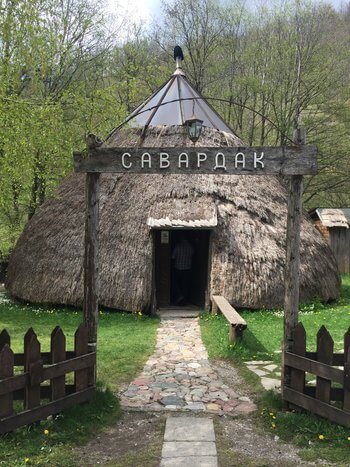 Savardak restaurant
Savardak restaurantInstead, I recommend Restoran Vodenica which has excellent food and service. I loved their 'meat in peasant mode', prebranac (beans), kačamak or cicvara (maize or cornmeal porridges), popara (bread cooked with clotted cream, butter and milk), roast meat, sausages and kajmak (clotted cream).
I also love Konoba Amanet (this is about 3 km out of town) which has fantastic food, service, and outdoor tables overlooking a river. There is also a beautiful while Samoyed dog who welcomes everyone as they arrive!
Everything is good here, but I especially love their sač, a traditional way of roasting meat under an iron dome.
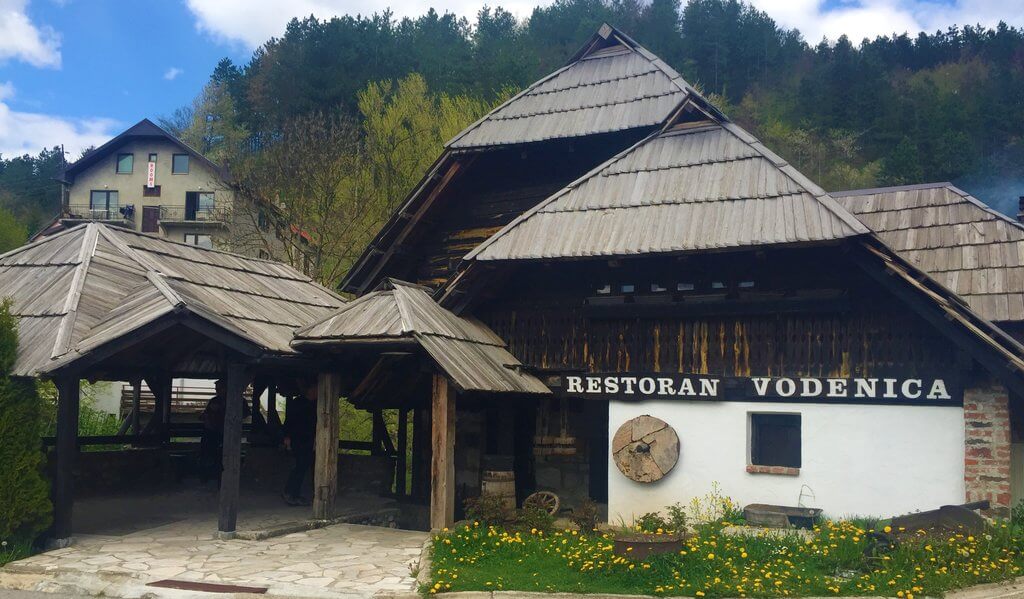 Vodenica restaurant in Kolašin
Vodenica restaurant in KolašinProkletije (Accursed Mountains)
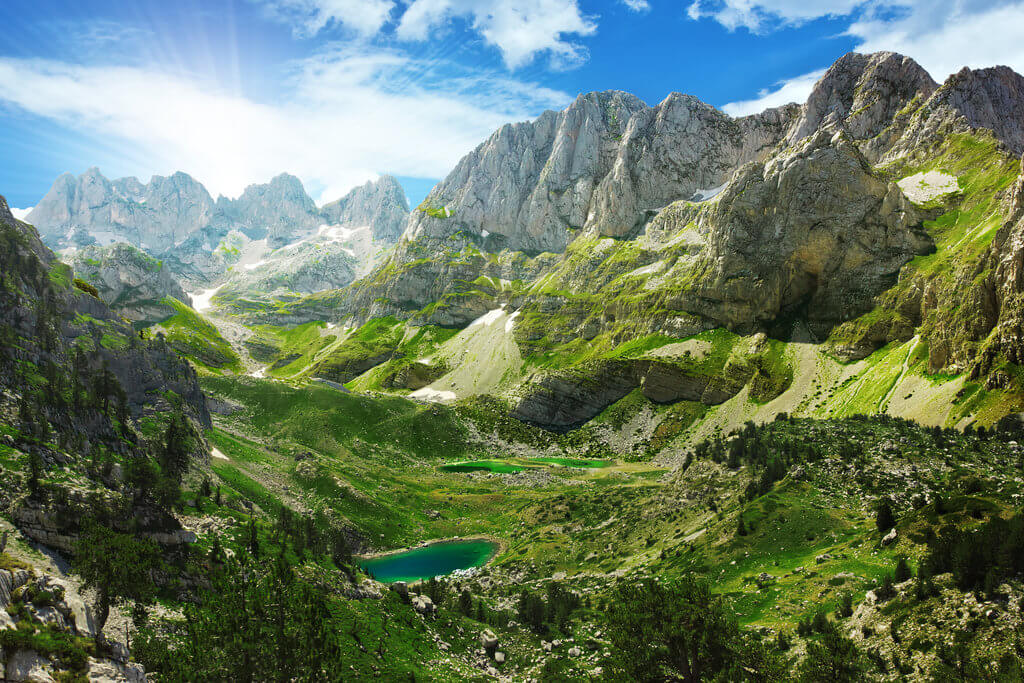 Prokletije National Park. Image: Deposit Photos
Prokletije National Park. Image: Deposit PhotosKnown as the "Accursed Mountains," Prokletije forms a stunningly rugged and dramatic border between Montenegro, Albania, and Kosovo.
This mountain range is famed for its sheer peaks, deep valleys, and the wild, untamed beauty that attracts adventurers from around the world.
Because it lies in the far north east of Montenegro, Prokletije is usually only visited by keen mountaineers and intrepid tourists. This means you'll find less in the way of tourist attractions, but also fewer tourists and a pristine and authentic environment.
Prokletije is ideal if you’re looking for a remote, challenging outdoor experience, offering some of the most dramatic alpine scenery in the Balkans.
Best Things to See and Do in Prokletije
- Hiking: Prokleije's 'Accursed Mountains' draw serious hikers from around the world. However, they're very dangerous should only attempted with a guide. This guided hiking tour has three options to suit every fitness level.
- Ali Pasha Springs: Beautiful natural springs with very clean water. This is a popular picnic spot and the most popular place in the area for proposals!
- Redžepagić Tower: Built somewhere between the 15th century and 1671 to defend Plav, this tower is now a small museum and significant historical monument in this area.
- Lake Plav: The largest lake in the area, Lake Plav is a popular spot for swimming and kayaking.
- Hrid Lake: Known as the 'Lake of Happiness', Hrid Lake is one of the highest altitude lakes in Montenegro at 1,970 meters. The lake lies on the 192 kilometer-long Peaks of the Balkans trail and it's said that swimming in the lake will bring you health and luck in marriage!
>> See more popular things to do in Prokletije here.
Highest Peaks in Prokletije
- Maja Jezerce (Albania): 2,694 meters
- Zla Kolata: 2,536 meters
Popular Hiking Trails in Prokletije
- Peaks of the Balkans Trail: This 192 km cross-border trail weaves through Montenegro, Albania, and Kosovo, offering a multi-day trekking experience that showcases the raw beauty of the Prokletije mountains.
You can take guided tours of the Peaks of the Balkans Trail or walk it on your own. If walking it on your own Rudolph Abraham’s The Peaks of the Balkans Trail is an essential guide. - Grebaje Valley - Volušnica (1,879) and Popadija (also called Talijanka, 2,057 m): 5 hrs. This is the most scenic and most popular hike in Prokletije. From Volušnica you’ll getting stunning views of the famed Karanfili Peaks. You can do this as a self-guided hike or book a guided tour from Podgorica.
>> Find more of the best hiking routes in Prokletije on this page.
Best Places to Stay Near Prokletije
- Plav: This small town near the shores of Plav Lake is a convenient base for exploring the Montenegrin side of Prokletije. It offers a range of guesthouses and hotels suited to various budgets. Click here to see accommodation in Plav.
- Gusinje: Close to the Albanian border, Gusinje provides a more authentic and rustic lodging experience, ideal for those looking to be close to nature and the starting points of numerous trails. Click here find accommodation in Gusinje.
Lovćen
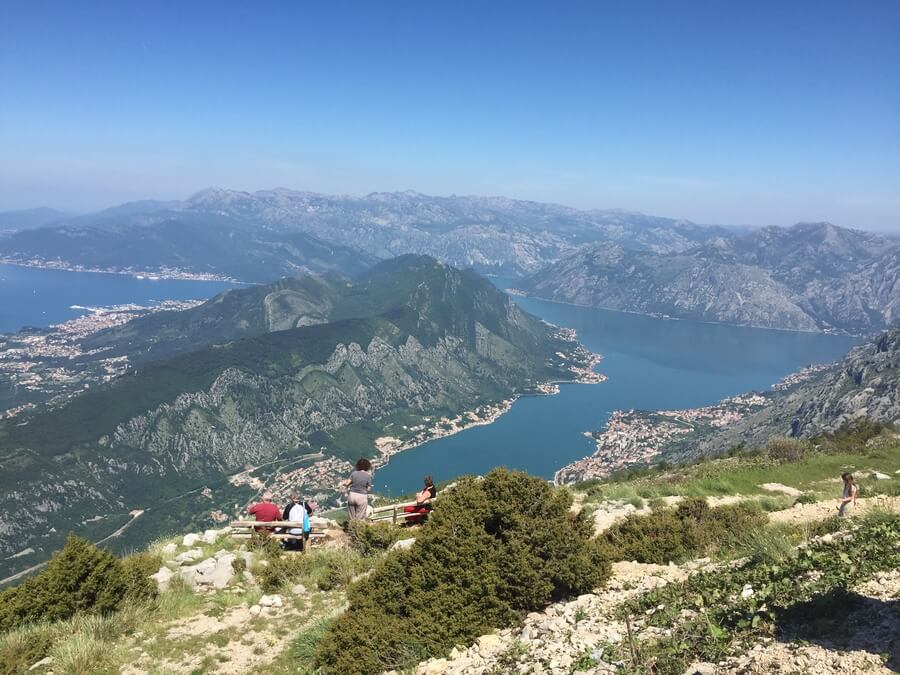 The Bay of Kotor from Lovćen National Park
The Bay of Kotor from Lovćen National ParkThe Lovćen mountain range, located in the southwestern part of Montenegro, rises dramatically from the Adriatic basin and is a symbol of Montenegrin pride and history.
Dominated by Lovćen National Park, the area blends natural beauty with cultural significance, highlighted by the Njegoš Mausoleum on top of its second-highest peak.
Lovćen offers you a combination of scenic landscapes, historical architecture, and panoramic views that stretch to the Bay of Kotor.
Best Things to Do on Lovćen
- Serpentine Road: From Kotor you'll drive up the serpentine road with its 25 hairpin turns. The view of the Bay of Kotor gets better with each turn until you enter the national park where you get the view above
- Njeguši Village: Njeguši is the birthplace of Montenegro's favorite ruler, Petar Petrović-Njegoš. The village is also famous for its prosciutto, cheese, and brandy.
- Petar II Petrović-Njegoš Mausoleum: The mausoleum on Jezerski Vrh, the second-highest peak on Mount Lovćen, is fascinating and you'll get views of Montenegro, Croatia and even Albania from the 360° lookout behind the mausoleum.
- Ivanova Korita: Ivanova Korita is the center of Lovćen. You'll find hotels, restaurants, grassy fields, playgrounds, walking tracks, bike rental, barbecue facilities, and Adventure Park Lovćen.
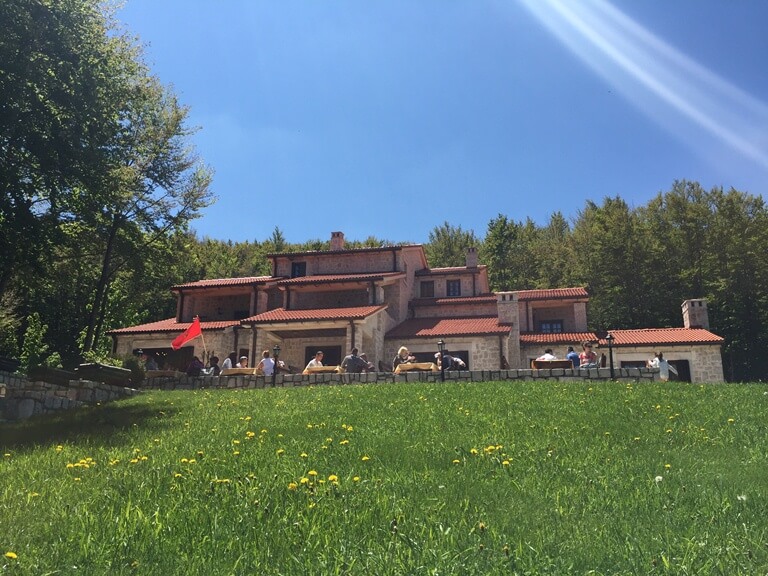 Ivanova Korita, Lovćen National Park
Ivanova Korita, Lovćen National Park- Adventure Park Lovćen: Adventure Park Lovćen has several high ropes courses ranging in difficulty. This is perfect for families.
- Cetinje: Cetinje is Montenegro's old royal capital. You can visit the former royal palace and the national museum. Although not part of the national park, most people combine a visit to Cetinje and Lipa Cave with a visit to Lovćen.
- Mountain Biking and Hiking: Explore the myriad of trails that crisscross the park, suitable for both mountain biking and hiking, offering diverse terrains and spectacular scenic vistas. This downhill biking tour from Lovćen to Kotor is very popular.
- Montenegro Full-Day Tour To Lovćen National Park And More: This is the best small group day tour to Lovćen National Park from the coast. I love it because it covers an incredible amount, is suitable for all ages and it's lots of fun. You can read my review here.
>> See more of the best things to do in Lovćen National Park here.
Local's Tip: There is no public transport to Lovćen, so the best way to get there is by hiring a car from Localrent.
Highest Peaks of Lovćen
- Štirovnik: 1,749 meters
- Jezerski Vrh: 1,657 meters
Popular Hiking Trails On Lovćen
- The Wolf’s Trail: This trail is a 7 km (4.4 mi) loop from Ivanova Korita. It’s a moderate hike that offers incredible natural beauty.
- Ivanova Korita to Jezerski Vrh: A moderately difficult hike to the Petar II Petrović-Njegoš Mausoleum.
You can find more information about hiking trails at the visitors center at Ivanova Korita.
Best Places to Stay Near Lovćen
- Cetinje: Located just a short drive from the park, Cetinje, the historical capital of Montenegro, offers a range of accommodations from traditional guesthouses to upscale hotels, all steeped in the charm of Montenegro's royal past. Search accommodation in Cetinje.
- Njeguši: For a more rustic stay, consider lodging in Njeguši, a small village famous for its traditional Montenegrin cuisine and smoked ham. There is limited accommodation available here. Search accommodation in Njeguši.
- Ivanova Korita: Hotel Monte Rosa has comfortable rooms and self-catering apartments at Ivanova Korita, the center of Lovćen National Park.
Rumija
Rumija is a striking mountain that forms a natural barrier between the Adriatic coast and Lake Skadar, located in southern Montenegro.
It is renowned for its spiritual significance and the annual religious procession to its summit, where followers of different faiths converge in a display of unity and tradition.
The mountain's diverse ecosystems, ranging from Mediterranean to Alpine, make it a fascinating and off-the-beaten-track destination.
Best Things to See and Do on Rumija
- Spiritual Pilgrimage: Participate in or observe the traditional cross-religious pilgrimage to the Church of Saint Jovan Vladimir at the summit, which symbolizes peace and coexistence among different faiths.
- Bird Watching: The lower slopes of Rumija, close to Lake Skadar, offer good bird-watching opportunities in Montenegro, with numerous species visible during migration seasons.
- Hiking: The trails up Rumija are less traveled compared to other Montenegrin mountains, offering a more secluded hiking experience with stunning views of both the coast and the lake.
- Jeep Safari: You can take a 3-4 hour jeep safari up Rumija that includes waterfalls and a delicious traditional lunch of homemade food and drinks.
Highest Peaks on Rumija
- Rumija Peak: 1,594 meters
Most Popular Hiking Trails on Rumija
- Bar to Rumija Summit: Starting from the coastal city of Bar, this trail ascends through olive groves and ancient ruins, reflecting the area's rich history, before reaching the mountain’s summit.
- PPT Orjen - Lovćen - Rumija: Also called the Coast - Mountain Transversal, this is one of two long-distance trails in Montenegro. It covers 180 km and takes around 10 days.
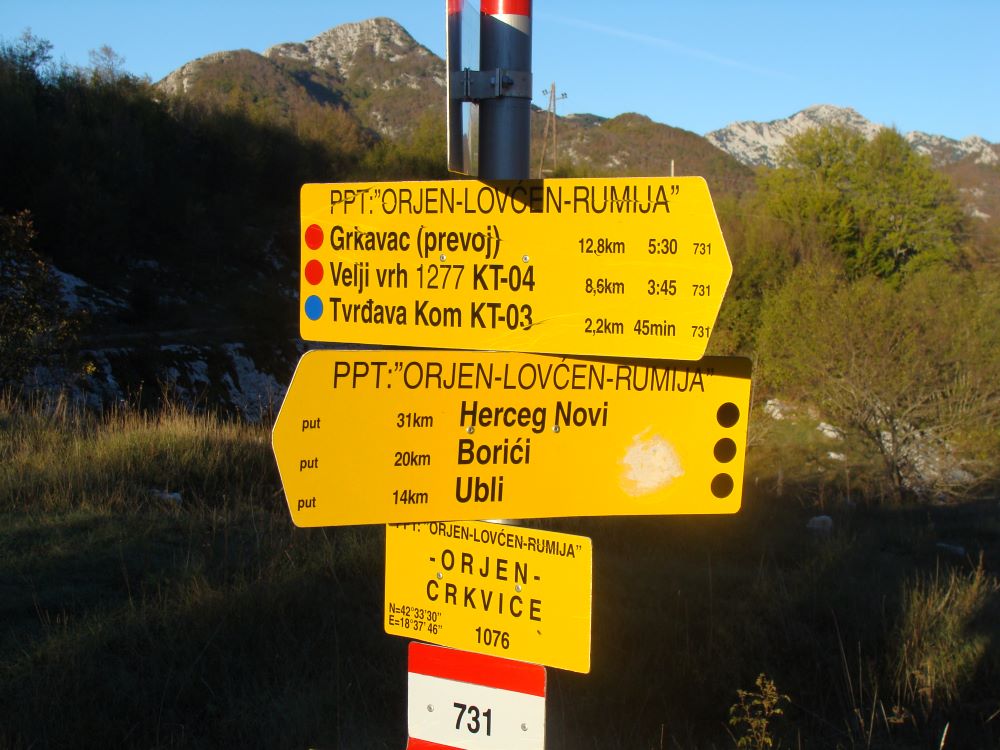
Best Places to Stay Near Rumija
- Bar: As the closest major city to Rumija, Bar offers a variety of lodging options, from beachfront hotels to cozy apartments. Click here to find accommodation in Bar.
- Virpazar: Located on the shores of Lake Skadar, Virpazar has charming accommodations, including traditional guesthouses and boutique accommodation like one of my favorites, Eco Resort Cermeniza. Click here to browse accommodation in Virpazar.
Orjen
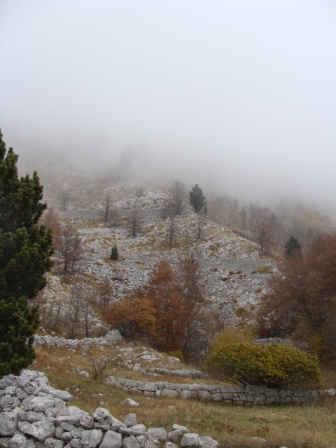 Mount Orjen
Mount OrjenOrjen is located in the far west of Montenegro near the Bay of Kotor and stretches to the border with Bosnia and Herzegovina.
It is the highest mountain of the Dinaric Alps in the coastal region, known for its imposing limestone peaks and lush, Mediterranean vegetation.
Orjen's unique microclimate brings substantial rainfall, creating vibrant, green landscapes that contrast beautifully with its rugged mountain terrain.
Orjen has nature park status in Montenegro.
Best Things to See and Do on Orjen
- Hiking: Explore Orjen's rich biodiversity on its well-marked trails, which boast a variety of endemic plant species unique to this microclimate.
The best place to find hiking trails here is on the Orjen Nature Park website or by contacting them. - Adventure Park Orjen: This tree-tops ropes park in Vrbanj has several levels for different ages, including a zipline. It's a great place for families! Here's a video of one of our visits.
- Historical Sites: Visit remnants of Austro-Hungarian fortifications scattered along the hiking trails, offering a glimpse into the mountain's strategic military importance in the past.
Highest Peaks on Orjen
- Zubački Kabao: 1,894 meters
- Veliki Kabao: 1,892 meters
Most Popular Hiking Trails on Orjen
- Subra Amphitheatre: A challenging but rewarding hike, this trail leads to the dramatic limestone amphitheater below Zubački Kabao, known for its impressive geological formations and spectacular vistas.
- Orjen Sedlo to Zubački Kabao: This trail starts from Orjen Sedlo, the mountain pass, and ascends to the summit, offering extensive views and encountering various historical sites along the way.
- Vrbanj to Orjenska Lokva: This trail starts in the village of Vrbanj and takes you through the forest to Orjenska Lokva, a small pond.
There, you'll also find a mountain hut, which isn't always open, but when it is you can get hot drinks, cook, and spend the night. It's best to contact them via the Nature Park Orjen website in advance.
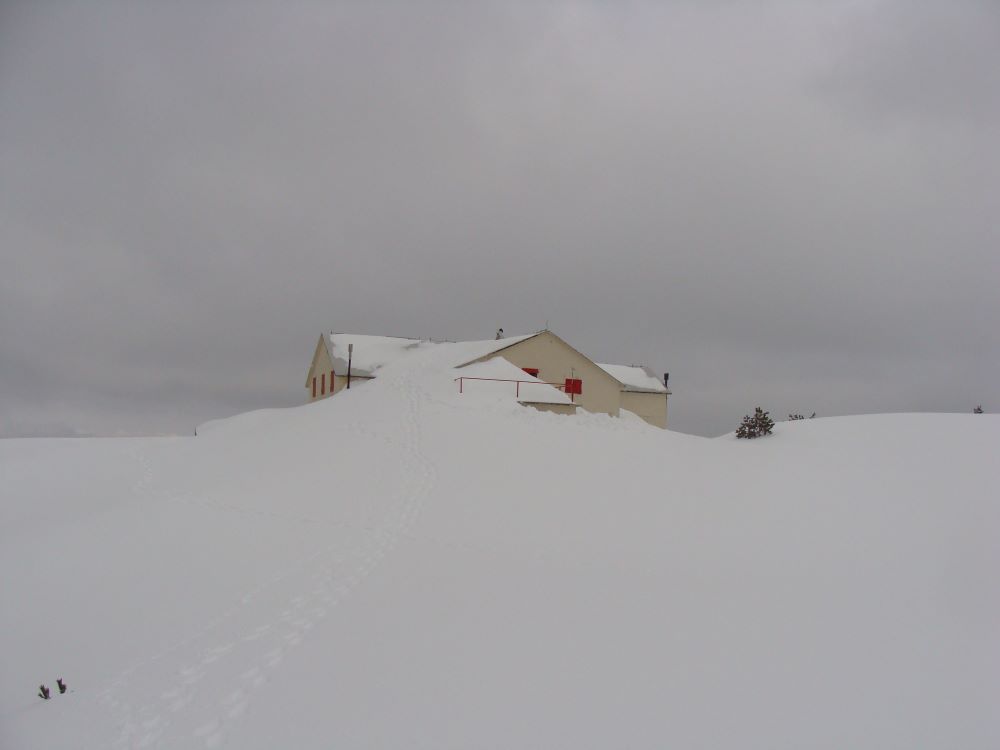 Mountain hut at Orjenska Lokva in winter
Mountain hut at Orjenska Lokva in winter- Borići to Mountain Hut Za Vratlom: There is a very nice path through the forest from Borići to Mountain Hut Za Vratlom. This is an easy hike and the mountain hut is open on the weekends. You can get hot, tasty meals and drinks, and meet lots of hikers.
To check opening times or make a booking, contact P.K. Subra.
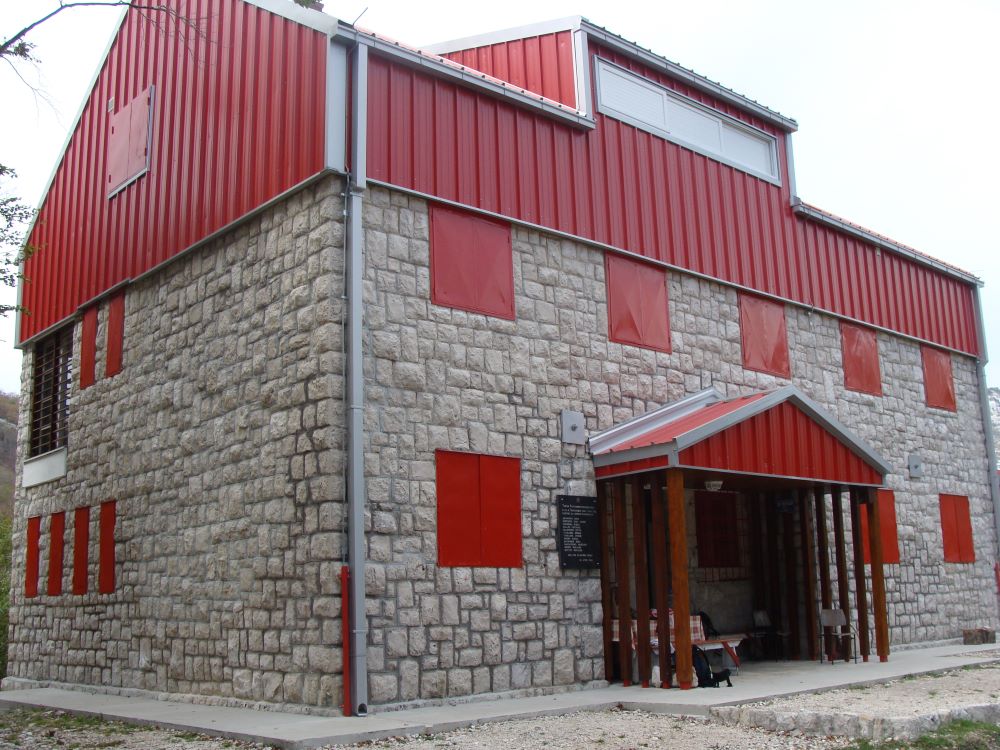
Best Places to Stay Near Orjen
- Herceg Novi: Nestled at the foot of Mount Orjen, Herceg Novi is a pretty and relaxed coastal town with a variety of accommodation options, from luxury resorts to private villas. Click here to find accommodation in Herceg Novi.
Komovi
Situated in the eastern part of Montenegro, the Komovi mountain range is part of the larger Dinaric Alps and is known for its majestic, wild landscapes and challenging peaks.
This area is a favorite among serious hikers and mountaineers looking for solitude and unspoiled nature.
The dramatic contours of the Komovi mountains offer some of the most breathtaking scenery in the Balkans, with dense forests and alpine meadows.
Best Things to See and Do in Komovi
- Hiking: Take on the challenge of climbing Komovi’s rugged peaks, particularly appealing to experienced climbers looking for less trodden paths.
- Eco-tourism: Engage with local eco-tourism initiatives that offer guided tours and sustainable travel experiences, highlighting the importance of conservation in this pristine area.
Highest Peaks in Komovi
- Kučki Kom: 2,487 meters
- Lijevoriječki Kom: 2469 meters
- Vasojevićki Kom: 2460 meters
Most Popular Hiking Trails in Komovi
- Kučki Kom: Kučki Kom offers similarly spectacular vistas and a slightly more technical climb, popular among seasoned mountaineers.
- Lijevoriječki Kom: The Lijevoriječki Kom hiking trail in Montenegro's Komovi range provides a moderately challenging path to the summit, offering hikers stunning views of the diverse landscapes that characterize this lesser-known but spectacular mountainous area.
- Vasojevićki Kom: Vasojevićki Kom reaches an altitude of 2,461 meters, offering you challenging ascents and rewarding panoramic views.
Best Places to Stay Near Komovi
- Andrijevica: Located at the base of the Komovi mountains, Andrijevica is a small town near the range with accommodations that range from simple guesthouses to more comfortable hotels. Click here to browse accommodation in Andrijevica.
- Katuns: For a more immersive experience, stay in one of the traditional mountain huts or katuns scattered around the Komovi area. These offer rustic lodging and local food prepared by the host families, which is a great way to experience authentic Montenegrin lifestyle and hospitality. I recommend highly-rated Komovi Eko Katun Martinovica 1750.
Sinjajevina
Sinjajevina, located between Durmitor and Bjelasica, is the largest mountain plateau in the Balkans and has 10 peaks over 2,000 meters.
This vast, open landscape is known for its pastoral beauty, traditional lifestyles, and significant biodiversity.
This incredibly valuable and biodiverse region includes 1,300 species plants, 40 of them protected. It is also home to 43 mammal species, with 15 strictly protected. There are at least 85 bird species here, most of them endangered.
The bird population in Sinjajevina includes 85 counted species, with the potential for 77 more. Most of these species are protected nationally and some internationally. The region is culturally rich, hosting 18 designated cultural properties and monuments.
Sinjajevina is also a vast pastoral area, covering 120,000 hectares. Although there has been a steep decline in population in the last few decades, up to 250 families live here over summer. Sinjajevina supports around 200,000 sheep and 10,000 cattle.
Here, you can see the traditional rural Montenegro way of life that has existed for centuries.
At present, Sinjajevina is under threat of being turned into a base for military activities. But active local groups are fighting the government's proposal.
Local's Tip: The roads in Sinjajevina are very poor, read: gravel and potholed. You will need a 4x4 if you want to go here. The best place to rent one is from Localrent.
Best Things to See and Do in Sinjajevina
- Hiking and Biking: Explore the extensive network of trails across the plateau, suitable for both hiking and mountain biking, offering easy to moderate paths with spectacular views of the surrounding mountains.
- Katuns: Sinjanjevina has many katuns where you can see the traditional way of life in Montenegro. Tourism is undeveloped here though, so you won't find any tours or tourist offerings.
Highest Peaks in Sinjajevina
- Babin Zub: 2,278 meters
- Jablanov Vrh: 2,204 meters
- Gradiste: 2,174 meters
Most Popular Hiking Trails In Sinjajevina
- Klisura to Babin Zub: A challenging hike, this trail leads to the summit of Babin Zub, rewarding hikers with expansive views of the entire region.
- Klisura to Jablanov Vrh: This 5 km trail takes you past several katuns to the summit of Jablanov Vrh. The last part of the ascent is demanding, but you'll get breathtakings views of the Moračke Mountains.
Best Places to Stay Near Sinjajevina
- Kolašin: Just a short drive from the plateau, Kolašin offers a variety of accommodations ranging from cozy mountain lodges to upscale hotels. Click here to find accommodation in Kolašin.
- Katuns: For a more authentic experience, stay in one of the traditional katuns (seasonal shepherd’s dwellings) on the plateau, where you can experience the unique lifestyle of the local communities. Katun Kuline has basic, but comfortable and welcoming traditional-style accommodation with stunning scenery.
What to Eat in the Mountains of Montenegro
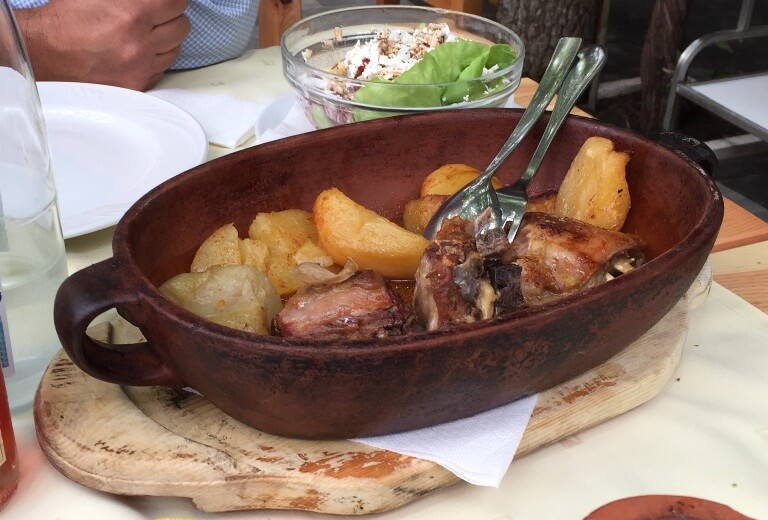 Sač, traditional roasted meat and potatoes
Sač, traditional roasted meat and potatoesThe cuisine in the mountains of Montenegro is distinctly different to what you'll find on the coast. Instead of seafood and fresh salads you'll find hearty, cooked meals and comfort food that's ideal after a day in the outdoors.
Here are some top dishes to try:
- Sač: Sač (pronounced 'such') is meat (usually lamb or veal, sometimes goat) that's been slow roasted under an iron dome. It comes with the best roast potatoes you've ever had and it goes best with a simple cabbage salad. Try this, you won't be sorry!
- Pasulj: This innocuous-looking bean stew that is cooked with smoked sausages will blow. Your. Mind
- Kačamak: Kačamak is a maize porridge that's made with potatoes and kajmak cheese, which is a kind of clotted cream
- Kajmak: You can also try kajmak on its own. Fresh kajmak is milder, while more aged kajmak is stronger. If you really want to go local head to the local farmers market and look for skorup, kajmak aged in a sheep's stomach
- Lamb cooked in milk: This dish is just what the name says. Lamb is slowly stewed in milk with vegetables and spices. The result is deliciously tender and flavorful meat
- Cheese: Layered cheese is a specialty here
- Cornbread: Made from buckwheat, barley, or corn
- Pies: Layers of filo pastry filled with regional cheese, meat or vegetables
Geology of the Mountains of Montenegro
The geology of Montenegro's mountains is characterized by a combination of limestone, dolomite, and other sedimentary rocks, which have been subjected to tectonic forces and erosion over millions of years.
This geological process has created dramatic features such as towering peaks, deep canyons, and karst formations, which cover over half of Montenegro's land area.
This High-Karst Zone includes the Orjen range, which features many caves and dangerous sinkholes (especially in winter when they are covered with snow). It also includes another popular, but dangerous, area popular with hikers: the Accursed Mountains. Both are part of the Dinaric Range, which was shaped by glaciers.
Montenegro's mountains are also home to glacial lakes, carved out by ancient glaciers during the Ice Age. There are 18 glacial lakes, known as 'mountain eyes' in Durmitor National Park.
Ecology of the Mountains of Montenegro
Montenegro is one of Europe's smallest countries, but it's one of the most biodiverse. Within the mountainous regions, a remarkable variety of ecosystems flourish, supporting a wide array of plant and animal species.
The diverse landscapes give rise to an impressive range of flora, with over 3,000 species of plants, including many endemics found only within Montenegro. From majestic forests of beech, oak, pine, and juniper to vibrant alpine meadows, the mountains are adorned with a tapestry of wildflowers, herbs, and trees.
The mountains of Montenegro are also home to a thriving wildlife population. The rugged terrain provides a sanctuary for numerous mammal species, including brown bears, wolves, lynx, wildcats, and chamois.
There are also over 330 bird species soaring through Montenegro's mountain skies. Rare and protected species like the Eurasian eagle-owl, Dalmatian pelican, and the endangered griffon vulture find refuge in these mountainous habitats.
In addition, the rivers and lakes nestled within the mountains are teeming with diverse fish species, contributing to the flourishing aquatic ecosystems.
Montenegro has three distinct ecoregions:
Balkan Mixed Forests
The Balkan Mixed Forest ecoregion covers Montenegro's northeastern and eastern borders.
Within this diverse ecoregion, you'll find pine trees, beech trees, oak trees, fir trees, and spruce trees. In the undergrowth, you may encounter wildflowers like the vibrant Turk's cap lily, the delicate lady's slipper orchid, and the aromatic mountain thyme.
These forests provide habitat for a wealth of wildlife, such as the elusive brown bear, graceful European lynx, Eurasian wolf, European wildcat and various bird species like the striking black woodpecker, melodious song thrush and Eurasian eagle-owl.
This ecoregion is also home to a range of smaller mammals, including the agile red squirrel and the shy European badger.
Dinaric Mountains Mixed Forests
The Dinaric Mountains mixed forests in Montenegro span across the central and eastern regions, and are characterized by a wide variation in elevations, resulting in two distinct forest zones within this ecoregion.
Between 1,200 to 2,500m (3,937 to 8,202 feet), you'll find the mountainous conifer zone, which is dominated by silver firs, black pines, and spruces.
Below 1,200m, the forests are dominated by broadleaf beeches and mixed oaks. Here, a diverse range of tree species flourishes, including Hungarian oaks, sessile oaks, downy oaks, common oaks, Turkey oaks, field elm, European ash, common hornbeam, maple, and rowan.
Several of Montenegro's national parks, such as Durmitor and the Accursed Mountains, are nestled within this bioregion, providing protected habitats for a remarkable array of wildlife.
Within these protected areas, you'll discover a great variety of mammals, including predators like the gray wolf, Eurasian lynx, Eurasian brown bear, red fox, Eurasian otter, and European wildcat. Herbivores and omnivores such as the wild boar, red deer, fallow deer, roe deer, and chamois also thrive in this region.
The ecoregion is home to numerous bird species, including the golden eagle, peregrine falcon, snake eagle, European honey buzzard, scops owls, Eurasian eagle owls, capercaillies, rock partridges, and snow finches.
Reptiles like Prokletije rock lizards, green lizards, fence lizards, horned vipers, adders, and Greek tortoises find their habitat within these forests, while amphibians such as the yellow-bellied toad, fire salamander, and fire-bellied toad also inhabit the region.
Illyrian Deciduous Forests
The coastal regions of Montenegro are dominated by Illyrian deciduous forests, which are made of mixed broadleaf zones below 1,200m (3,937 feet) and coniferous forests above 1,200m.
The conifer forests are made of of mixed firs, spruces, beeches, and pines, while the broadleaf zones are made of beeches and mixed oaks. Along the coastal areas, you'll predominantly find Aleppo pines, maquis shrubs, and holm oaks.
The Illyrian deciduous forests of Montenegro also serve as home to a diverse range of bird species, including capercaillies, peregrine falcons, kestrels, and griffon vultures.
Frequently Asked Questions About The Mountains of Montenegro
When is the best time to visit Montenegro's mountains?
When is the best time to visit Montenegro's mountains?
The best time to visit Montenegro's mountains is during the summer months, from June to September, when the weather is pleasant for outdoor activities like hiking and exploring. However, if you're interested in winter sports, the winter season from December to February offers opportunities for skiing and snowboarding.
Are the hiking trails in Montenegro's mountains suitable for beginners?
Are the hiking trails in Montenegro's mountains suitable for beginners?
Yes, Montenegro's mountains offer hiking trails suitable for beginners. Durmitor National Park, for example, has trails of varying difficulty levels, allowing hikers of all abilities to enjoy its stunning landscapes. It's always a good idea to choose trails that match your fitness level and consult with local guides for recommendations.
Can I see wildlife in Montenegro's mountains?
Can I see wildlife in Montenegro's mountains?
Yes, Montenegro's mountains are home to a diverse range of wildlife. Durmitor National Park, for instance, offers opportunities to spot rare species such as lynx and bears. Keep your eyes peeled while exploring, but remember to maintain a safe distance and never disturb or feed the wildlife.
Are there accommodation options near Montenegro's mountains?
Are there accommodation options near Montenegro's mountains?
Yes, there are accommodation options near Montenegro's mountains to suit different preferences and budgets. From cozy guesthouses and mountain lodges to hotels and campsites, you'll find a range of choices. Popular towns like Žabljak and Kolašin serve as excellent bases for exploring the nearby national parks.
Can I visit Montenegro's mountains as a day trip from the coastal areas?
Can I visit Montenegro's mountains as a day trip from the coastal areas?
Yes, it's possible to visit Montenegro's mountains as a day trip from coastal areas. Lovćen National Park, for example, can be reached within an hour from popular coastal towns like Budva or Kotor. However, to fully immerse yourself in the mountain experience and explore multiple national parks, consider dedicating a few days to your mountain adventure.
Related Articles
- Best Things to Do in Kolašin
- Best Things to Do in Žabljak
- National Parks of Montenegro
- Rafting in Montenegro
- Canyoning in Montenegro
- Via Ferrata in Montenegro
- Lipa Cave in Montenegro
- Durmitor National Park
- Lovćen National Park
Book Your Trip With My Recommended Providers
- Find a deal! Click here to see current deals on tours and activities.
- Accommodation with Booking.com
- Tours and activities with Get Your Guide
- Tours and activities with Viator
- Cheap car hire with Localrent.com
- Cheap flights with WayAway
- Organised adventure tours with TourRadar
- Transfers with Kiwitaxi
- Travel insurance with SafetyWing
- Home
- Top Montenegro Destinations
- Mountains of Montenegro Travel Guide
